Recipes: Herby Home Baking
Chocolate Mince Pie Brownies with fragrant herbs

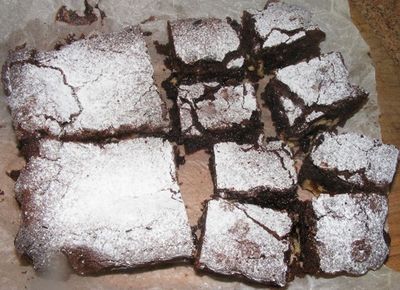
We have added finely chopped lavender tips to our brownies but you can, if you if you prefer, substitute rosemary or even one of the fruity scented thymes like orange or lemon. Which ever herb you choose make sure you only use the tender tips, and chop finely as the cooking time is quite short.
A soft tempting bread which should be eaten warm the day it is made. Alternatively it can be frozen as soon as it is cool, and re-warmed and decorated when needed.
- 190g unsalted butter
- 150g good dark chocolate
- 1 rounded tbsp of your chosen herbs
- 3 large eggs
- 275g caster sugar
- 85g plain flour
- 45g cocoa powder
- 9 mini mince pies
- Icing sugar to decorate
Method:
- Break up the chocolate and put it into a bowl with the butter. Microwave in short 30 second blasts until melted and combined. Alternatively, you can do this with the bowl over a pan of simmering water. Once melted mix in your herbs and allow the mixture to cool.
- Line a 20cm square baking tin with baking paper + pre-heat your oven to 180°C / 160°fan / Gas 4.
- Using an electric mixer whisk together the sugar and eggs on high speed for 3 – 4 minutes until thick and creamy.
- Very gently fold in the herby chocolate mixture with a spatula. Be careful not to knock out the air that you have beaten in. Carefully sieve in the flour and cocoa, and fold in gently until incorporated.
- Add enough of the mixture to cover the bottom of the lined tin. Add the mince pies spaced out evenly and cover with the rest of the brownie mix. Giving it a little shake to fill any spaces.
- Level off the top and bake for 25 – 30 minutes.
- The top should have an almost papery crust and the edges should be just coming away from the sides of the tin.
- Leave in the tin until completely cold and then dust with sieved icing sugar and cut into 16 squares.
- These brownies will keep for up to a week in a tin, or freeze until you have guests for tea!
Gözleme


This makes enough for 4 people (or 6 as a snack / starter)
The dough is a bread dough — you can either buy a bag of bread mix to speed things along,
or make the dough recipe for our flatbreads (omitting the herbs).
See www.manorfarmherbs.co.uk/recipeinfo/flatbread.
The dough will be ready to use for this recipe after it has been kneaded and risen until doubled in size.
The filling:
- 1 tbsp olive oil
- 1 red onion, finely sliced
- 150g spinach
- 150g feta cheese
- 15g grated parmesan
- 3 tbsp thick greek yoghurt
- a good pinch of nutmeg and cayenne
- Handful of chives – snipped small
Method:
- Whilst the bread dough is rising, prepare the filling.
- In a large pan sauté the onion in the oil for about 5 minutes until well softened but not brown. Add the spinach and cook for a couple more minutes until it is wilted. Set aside to cool completely.
- Crumble the feta into a bowl and add the parmesan, yoghurt, spices and chives along with some salt and black pepper to taste.
- On a floured surface knead the dough just once to remove the air and divide into 4. Roll out each piece as thinly as you can, and trim to give a square about 20cm x 20cm. (Any leftover trimmings can be rolled together to make flatbreads or small pizza bases)
- Spread a quarter of the cheese mixture in the centre of the square to make a rectangle about 10cm wide x 15cm long. Cover with a quarter of the spinach mix.
- Fold the sides of the dough over the filling first from the right and then from the left. Then bring up the top and bottom flaps to make a neat parcel.
- Repeat this with the rest of the dough and filling.
- Heat your heaviest frying pan on a low to medium heat. Once heated through add a drizzle of oil and gently fry the gözleme two at a time, turning gently until they are golden and crisp.
- Transfer to a warm oven whilst you cook the remaining pieces.
- Make sure that you allow these to cool for a few minutes before eating as the cheese inside will be very hot!
These gözleme are lovely cut into quarters and served with a green salad. They are also good picnic fare as they are equally tasty at room temperature and transport well packed into tupperware boxes.
Candied Orange and thyme loaf

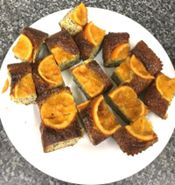
Our Candied Orange and thyme loaf will be an easy addition to your repertoire. Just remember to get
ahead by preparing the oranges in advance, this can even be done the day before.
You will need 2 x oblong loaf tins, oiled and lined with baking paper. You can of course halve the
ingredients and make just one cake, but as they freeze so well it is no extra effort to make 2!
- 4 oranges
- 200g granulated sugar
- 200g plain flour
- 60g ground almonds
- 200g caster sugar
- 50g poppy seeds
- 1 tsp baking powder
- 4 tsp finely chopped orange thyme
(lemon or broad leaf thyme can be used instead) - 4 large eggs
Prepare your oranges:
- Put 2 of the whole oranges in a small pan, cover with water and simmer gently for 1½ hours. Leave to cool.
- Dissolve the granulated sugar in 400ml of water over a low heat.
- Slice the remaining 2 oranges about 1cm thick and add to the sugar syrup.
- Simmer for about 20 minutes until soft, then leave to cool in the syrup.
The cake:
- Preheat your oven to 150°C fan, 170°, Gas 3.
- Roughly chop the whole boiled oranges and remove any seeds. Mince them in a food processor.
- In a large bowl mix together all of the remaining dry ingredients, add the orange pulp and the beaten eggs and mix well.
- Divide the mix between the 2 prepared tins and top with the caramelised orange slices prepared earlier.
- Brush the slices with some of the syrup in the pan and bake for 50 minutes, until a skewer in the centre of the cake emerges clean.
- Cool the cakes for 15 minutes in their tins before removing to cool completely on a rack.
Keep the orange syrup in a small jar — great for adding to cocktails and soft drinks!
Lemon and Rosemary Sablés

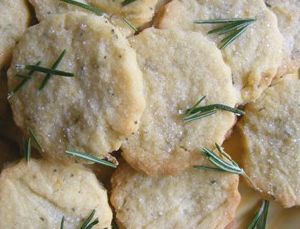
Makes about 40
- 250g good quality butter – softened and cubed
- 160g white granulated sugar
- 2 tbsp very finely chopped rosemary
- Zest from 2 small lemons (or 1 large one)
- 2 egg yolks
- 330g plain flour
- 2 tbsp extra sugar to sprinkle
Method:
- Line 2 large baking trays with baking paper.
- With an electric beater, cream together the butter, sugar, rosemary and zest until it is pale and creamy. Adding the rosemary at this point allows the flavours to infuse in the mixture.
- Beat in the egg yolks until just combined then fold in the flour.
- Wrap the dough tightly and put in the fridge for 20 minutes to rest.
- Pre-heat your oven to 170ºC, 150ºC fan.
- When the dough is chilled roll out gently on a lightly floured work surface to about 5 mm thick and use a 5cm biscuit cutter to cut out rounds. Transfer these to the prepared baking sheets. Any trimmings can be rerolled for cutting.
- Sprinkle the biscuits on the trays generously with the extra sugar and bake for 10 – 12 minutes. Keep an eye on them for the last couple of minutes as all oven vary! Cool the biscuits on the baking trays before they are ready to serve.
These are lovely with a cup of tea or coffee (or even a glass of wine!). They are also perfect served with ice-cream.
Apple, Sage and Cinnamon Crumble cake

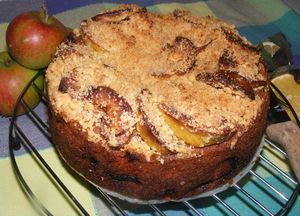
Ingredients for the cake:
- 300g cooking apples – peeled, cored and diced into 1cm pieces
- 1 lemon
- 225g soft butter
- 225g caster sugar
- 3 large eggs
- 10 large sage leaves – sliced then chopped
- 225g self raising flour
- 1 tsp baking powder
- 1½ tsp ground cinnamon
- 50g ground almonds
Ingredients for the crumble:
- Splash of olive oil
- 2 small eating apples – cored and sliced into 6 slices per apple
- 30g chilled butter
- 50g plain flour
- 30g demerara sugar
- 1 heaped tsp chopped sage leaves
Method:
- Preheat the oven to 180ºC / 160ºC Fan / Gas 4. Lightly grease and line a 20cm loose bottomed cake tin.
- Zest the lemon into a large mixing bowl with the softened butter and caster sugar.
- Squeeze the lemon juice into a smaller bowl and toss in the apple chunks, stirring to ensure they are all coated in the juice.
- With a hand mixer cream together the butter, sugar and zest until pale and fluffy. Beat in the eggs one at a time with a spoonful of the flour at each addition to stop the mixture curdling.
- Gently fold in the sage, flour, baking powder, cinnamon and almonds.
- Drain the apple chunks well and dry on kitchen paper and fold these into the mixture.
- Transfer the cake mix to the prepared tin, smoothing down gently so no pieces of apple protrude.
- Bake for 45 minutes.
Start preparing the crumble topping:
- On a medium heat fry the apple slices until they start to brown on each side.
- Rub together the butter and flour to make a breadcrumb-like mix then stir in the sugar, sage and cooled apple slices.
- When the cake has had its 45 minutes top with the crumble mix and bake for a further 20 minutes until the topping is golden brown.
- Leave to cool in the tin for 10 minutes before removing onto a serving plate.
The cake can be served warm, or cool and slice for a tea or coffee time treat.
Buttery Herb Christmas Tree

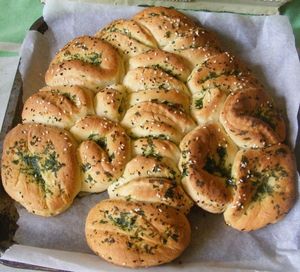
Our Buttery Herb Christmas Tree is a fragrant & herby treat to share.
- 2 tbsp sugar
- 1 tsp salt
- 60g soft butter - cubed
- 400g strong bread flour
- 1 sachet Quick easy bake yeast (7g)
- 115ml milk – at room temperature
- 2 tbsp warm water
- 1 large egg – at room temperature
For the herb butter:
- 60g soft butter
- 2 tbsp chopped soft herbs
(Parsley, oregano, chives — whatever you have to hand) - ¼ tsp chilli flakes or cayenne
- 1 tsp each nigella and sesame seeds to decorate
Method:
- Using a large bowl add all of the dry ingredients and the butter.
- Beat together the milk, water and egg and pour this mixture into a well in the centre of the dry ingredients. Gradually mix together to form a firm dough.
- Knead the dough on a lightly floured surface until smooth and elastic. This will take about 6 or 7 minutes. Lightly oil another large bowl. Add the dough, cover and leave the dough to rise until doubled in size in a warm place.
- You can of course do this in a bread maker if you have one – following the machine instructions on the dough setting.
- Whilst the dough is rising combine all the herb butter ingredients and set aside a tablespoon for the final glaze.
- When the dough is ready, turn it onto a lightly floured surface and knead briefly. Roll out into a sheet about 2 - 3mm thick.
- Cut out seventeen 8cm circles, you may need to re-roll the scraps for the final few.
- Spread the herb butter on the centre of each circle leaving a thin unbuttered rim around the edge.
- Using the back of a knife, make a crease off centre on each circle.
- Fold along the crease.
- Pre heat the oven to 180ºC / 160ºC Fan / 350ºF and line a 30cm baking sheet with baking paper.
- Place one folded circle at the top centre of the baking sheet, and arrange 14 more circles in rows below to form a tree shape.
- Moisten the dough with water where it overlaps to get a good seal.
- Use the remaining 2 circles to make the trunk.
- Melt the reserved herb butter and brush all over the tree and sprinkle with the seeds to decorate.
- Leave the tree in a warm place, lightly covered, to rise for about 40 minutes, before baking for 15 – 20 minutes.
A great 'tear and share bread' to serve warm with dips or cheese, or as a side to your meal.
Candied Orange and thyme loaf


Our Candied Orange and thyme loaf will be an easy addition to your repertoire. Just remember to get
ahead by preparing the oranges in advance, this can even be done the day before.
You will need 2 x oblong loaf tins, oiled and lined with baking paper. You can of course halve the
ingredients and make just one cake, but as they freeze so well it is no extra effort to make 2!
- 4 oranges
- 200g granulated sugar
- 200g plain flour
- 60g ground almonds
- 200g caster sugar
- 50g poppy seeds
- 1 tsp baking powder
- 4 tsp finely chopped orange thyme
(lemon or broad leaf thyme can be used instead) - 4 large eggs
Prepare your oranges:
- Put 2 of the whole oranges in a small pan, cover with water and simmer gently for 1½ hours. Leave to cool.
- Dissolve the granulated sugar in 400ml of water over a low heat.
- Slice the remaining 2 oranges about 1cm thick and add to the sugar syrup.
- Simmer for about 20 minutes until soft, then leave to cool in the syrup.
The cake:
- Preheat your oven to 150°C fan, 170°, Gas 3.
- Roughly chop the whole boiled oranges and remove any seeds. Mince them in a food processor.
- In a large bowl mix together all of the remaining dry ingredients, add the orange pulp and the beaten eggs and mix well.
- Divide the mix between the 2 prepared tins and top with the caramelised orange slices prepared earlier.
- Brush the slices with some of the syrup in the pan and bake for 50 minutes, until a skewer in the centre of the cake emerges clean.
- Cool the cakes for 15 minutes in their tins before removing to cool completely on a rack.
Keep the orange syrup in a small jar — great for adding to cocktails and soft drinks!
A Harvest Loaf — French Fougasse bread

This makes 2 loaves which freeze really well if you don't need them both at once.
The dough is very soft and sticky rather like a focaccia, so it is easier to use a mixer with a dough hook or a bread machine on 'dough mode' rather than your hands to knead.
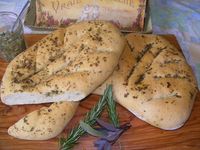
- 350 ml tepid water
- 2 tbs olive oil
- 500g strong white bread flour
- 1 tsp salt
- ½ tbs sugar
- 7g sachet of easy bake yeast
- 2 tbs mixed chopped herbs — choose from a mix of rosemary, thyme, winter savory and sage
- Coarse black pepper and dried oregano flakes to top the loaves
If you are using a bread machine on the dough setting add the first 6 ingredients to the pan in the order suggested in your instruction booklet. Reserve a tablespoon of flour and stir into the chopped herbs, these can go into the dispenser which adds nuts, fruit etc part way through the cycle.
To use a mixer like a Kenwood Chef or similar, put the flour, salt, sugar and yeast into the bowl and add the water and oil. Mix with the dough hook slowly until the dough has formed and then mix on medium for 8 – 10 minutes, adding the herbs about a minute before the end. The dough should be shiny and elastic.
You can, of course, knead by hand but this is a very sticky dough and you will need to scrape back your hands and the worktop regularly. To bake:
- Preheat your oven to 200°C / Gas mark 7
- When your dough is prepared — by whichever method — turn it onto a floured worktop and divide in two.
- Line two large baking sheets with baking paper and put half of the dough onto each sheet.
- Gently press each dough ball flat with the heel of your hands into an oval or leaf shape.
- Using a sharp knife or a small pizza cutter, make a slit down the centre of each dough shape stopping before you reach the edge of the dough.
- Make 3 – 4 cuts at a diagonal on either side of this central cut like veins of a leaf, again don't cut
right to the edge. - Open up the cuts a little with your finger and then brush the dough generously with olive oil and sprinkle with the oregano and black pepper.
- Leave these to rise in a warm place for 30 – 45 minutes or until they are doubled in size.
- Then bake for 20 – 25 minutes until the base sounds hollow when tapped.
Great served warm from the oven with soup or salad or as an accompaniment to most meals.
Biscuits with a Hint of Mint

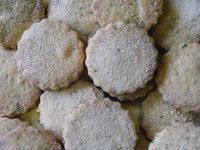
- 2 tbsp finely chopped 'After Eight' mint
- 150 g plain flour
- 100 g butter
- 2 tsp peppermint extract
- 50 g golden caster sugar
- Extra sugar to sprinkle after baking
The oven should be preheated to 180°C / 160°F / Gas Mk 4.
Line a large baking tray with baking paper.
In a large bowl stir together the flour, chopped mint and peppermint essence,
then rub in the butter with your fingertips until it is all blended in.
Alternatively this can quickly be carried out in a food processor.
Stir in the sugar.
Tip out onto a work surface and knead the dough until it comes together to form a rather crumbly ball.
Lightly flour the work surface and gently roll out the dough to about ½ cm thick and cut out rounds with your smallest cutter,
4 – 5 cm diameter is ideal.
Reroll the trimmings to make extra biscuits.
Bake on the lined baking tray for 12 – 15 minutes until they are pale gold.
Transfer to a cooling rack and sprinkle with extra caster sugar before serving.
Lime and Thyme flavoured Muffins, with Vodka Lime syrup

Makes about 12 – 14 muffins.
The quantities can easily be halved, and they freeze well if you make a large batch.
- 140 g (5 oz) butter — softened at room temperature
- 2 tsp fresh lime juice
- 280 g (10 oz) sugar
- 6 eggs — at room temperature
- 280 g (10 oz) plain flour
- 1 tsp baking powder
- ½ tsp salt
- 3 tbs lime zest
- 1½ tbs finely chopped thyme leaves
For the syrup
- 50 g (2 oz) sugar
- 50 ml lime juice
- 50 ml vodka
Preheat the oven to: 160C, 140C fan, 325F, or Gas 3.
In a large mixing bowl beat together the butter, sugar and lemon juice until the mixture is pale and fluffy.
An electric mixer is a great help.
Gradually beat in the eggs, one at a time, making sure that each is well mixed in before you add the next.
In another bowl mix together the remaining dry ingredients for the muffins.
Add this a little at a time to the whisked butter and egg mix until everything is well combined.
Check your beater blades when you have finished as, if your zest is in longish strips,
then some may well have wound themselves around the blades and will need to be scraped off back into the muffin mix.
Spoon the muffin mix into paper muffin cases in a muffin tin, filling each about ¾ full as they will rise when baked.
Bake for 30 minutes until golden brown.
TIP — The muffin cases are best if baked in a muffin tin as this prevents the cases from spreading during baking. If you don't have a deep muffin tin then use an ordinary shallower bun tin and use double muffin cases to give a bit more support.
Whilst the muffins are baking make the syrup.
Heat the ingredients in a small saucepan until boiling, stirring to dissolve the sugar.
Boil gently until the syrup reduced a little. Keep warm until the muffins are ready.
Whilst the muffins are hot, brush the tops repeatedly with warm syrup to flavour and glaze them.
Cool and serve!
Spicy Orange, Cherry and Rosemary Christmas Wreath

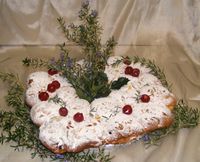
A soft tempting bread which should be eaten warm the day it is made. Alternatively it can be frozen as soon as it is cool, and re-warmed and decorated when needed.
- 2 eggs
- Milk (approximately 300 ml)
- 500 g strong bread flour
- 50 g butter — cut into small chunks
- 4 tbs sugar
- 1 tsp salt
- 1 tbs finely chopped rosemary
- 1 tsp ground ginger
- 1½ tsp grated nutmeg
- Zest of a large orange
- 2 tsp vanilla extract
- 2½ tsp dried yeast
- 75 g dried cherries
- 50 g melted butter
- 3 tbs flaked almonds
To decorate:
- 3 tbs icing sugar
- A tub of glace cherries
- Rosemary and holly leaves
Firstly prepare the liquid, break the eggs into a measuring jug, beat lightly and make up to 350 ml
with milk at room temperature.
Sift the flour into a large mixing bowl and mix in all the other ingredients
except for the cherries,
almonds and melted butter. Make a well in the centre and add the prepared liquid.
Gradually mix together to give a slightly sticky dough.
Turn this out onto a floured surface and knead for about 5 minutes.
Gradually knead in the cherry pieces for 5 minutes more. The dough should be smooth and elastic.
Cover the bowl and leave in a warm place for about an hour until doubled in size.
Line a very large square baking sheet with baking paper and position an upside-down oven-proof
circular ramekin (about 8 – 10 cm diameter) in the centre.
Punch the dough back and divide into 24 pieces, rolling each piece into a ball.
Assemble the wreath, dippping each ball in the melted butter as you work.
Space a ring of balls around the ramekin with a 5 mm gap between each.
Make a second ring around the first, spacing the balls slightly apart in the same way.
Brush any remaining butter over the top of the dough and sprinkle on the almonds pressing in lightly.
Cover loosely with oiled clingfilm and leave to rise for 30 – 45 minutes, until doubled in size.
Bake at 180°C / 350°F / Gas Mark 4 for 30 to 40 minutes until lightly golden brown.
If the almonds brown too quickly, lay a sheet of foil loosely over the top to protect them after 20 minutes.
Ease out the ramekin and cool the bread a little on the baking paper.
Decorate with sifted icing sugar, glace cherries and lots of foliage.
You can, of course, use your bread maker on the dough setting, adding the ingredients in the order
suggested in the instructions, and putting the dried cherries in the dispenser.
Flatbread with lots of herbs and garlic

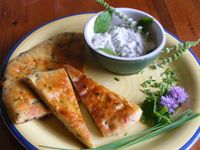
This recipe makes 4 good sized flatbreads. Any extra flatbread freezes really well, or you can save it until the next day and use to make Fattoush — a light and summery salad for summer lunch
- 1 tbs fast action yeast
- 1 tsp sugar
- 150 g unflavoured Greek Yoghurt — at room temperature
- 3 tbs warm water
- 60 ml extra virgin olive oil
- 320 g white bread flour
- 4 tbs coarsely chopped soft herbs e.g. parsley, chives, oregano, basil or your own choice
- 4 tbs olive oil with 2 cloves of finely chopped garlic to finish the breads
If you have a bread maker, put the liquids into the pan, and then the dry ingredients and herbs, switch to a 'dough' setting.
As flour and yoghurt are variable in moisture content, it is good to check back on the machine
after a couple of minutes in case the dough is too dry, in which case add a little more water as it kneads.
You can, if you prefer, knead the dough by hand.
Sift the flour into a large bowl and make a well in the centre,
add the wet ingredients and gradually incorporate to make a smooth dough.
Knead on a lightly floured service for 10 minutes then transfer to an oiled bowl
covered in clingfilm for 2 hours until doubled in size.
Whilst the dough is rising put the oil and garlic into a small pan and heat gently for 5 minutes.
Don't let the garlic brown.
Set aside to cool.
When you are ready to cook, divide the dough into 4 pieces and roll out on a lightly floured surface.
I usually aim for about ½ cm thick, thicker dough results in softer flatbreads and
thinner dough makes much crispier ones.
The choice is yours!
You can, of course, cook in the oven preheated to its highest temperature, for 6 – 8 minutes until golden brown.
However a hot oven in the kitchen in the summer is not always a good thing, and a grill with a ridged griddle pan,
or even a heavy based frying pan makes excellent flatbreads.
Preheat the grill to high for about 5 minutes then generously oil your griddle pan and
heat this for a minute or so.
Cook the flatbreads one by one for 2 – 3 minutes on each side until nicely brown and puffy.
Anoint each one with the garlic oil before serving.
Buttery Rosemary and Sultana Rolls

The rosemary and fruit go especially well together, making bread rolls which can be used both for sweet and savoury purposes. Makes 10.
- 1 egg
- 150 ml milk
- 1 tbs sugar
- 30 g butter – chopped
- 1 tbs rosemary leaves – finely chopped
- 1 tsp salt
- 280 g bread flour (A mix of white and wholemeal is nice)
- 1½ tsp quick action yeast
- 50 g sultanas
- 50 g softened butter
Mix the flour, sugar, salt, rosemary, yeast and 30 g of butter in a large bowl.
Make a well in the centre and add the egg and milk.
Incorporate into a dough and then turnout onto a lightly floured surface and knead for 5 minutes.
Add the sultanas to the dough and knead until they are evenly mixed in.
Return the dough to the bowl and leave to rise in a warm place until doubled in size.
You may of course use your breadmaker:
Simply add the ingredients in the order specified by your machine, adding the sultanas at the beep, and use the dough setting.
Whilst the dough is rising, preheat your oven to 180°C, 350°F, Gas Mark 4
and use a little of the softened butter to grease a muffin tin.
Roll the dough to make a rectangle roughly 8 mm thick and spread with the softened butter.
Cut the rectangle lengthways into 4 strips and stack these one on top of the other.
Cut the stack into 10 pieces with a sharp knife and carefully transfer each piece to the muffin tin.
Again leave to rise until the dough pieces have doubled in size and filled the muffin cups.
Bake for 20 – 25 minutes until just golden.
These make great dinner rolls to serve with soup and taste equally good spread with butter and jam for tea.
Rosemary and Orange Drizzle Cake

A lovely moist and sticky cake, easily made in the food processor.
Just plan in advance as the oranges need to be cooked for an hour before the cake can be baked.
- 2 large oranges
- 2 tsp finely chopped fresh rosemary
- 250 g caster sugar
- 150 g ground almonds
- 150 g self raising flour
- 6 eggs
- 2 tsp demerara sugar
For the orange drizzle:
- 3 tbs Cointreau or similar orange liqueur
- 1 tsp very finely chopped fresh rosemary leaves
- 100 g sugar
- zest from a large orange
Put the 2 oranges in a small pan, cover with water and simmer for an hour, drain and cool.
Preheat the oven to Gas 4 / 180°C / 160°C fan.
A 23 cm cake tin is needed, preferably with a loose bottom or springform sides.
Grease well and line with baking paper.
Halve the oranges, and remove the seeds.
Chop the oranges roughly and whizz in the food processor to a thick puree.
Add all of the rest of the cake ingredients except for the demerara sugar and blend well.
Pour all of the mixture into the lined tin and sprinkle over the demerara sugar.
Bake for 55 minutes to 1 hour, when the cake should be risen and golden.
Leave the cake to cool in the tin.
Meanwhile make the orange drizzle sauce.
Boil together the sugar with 100 ml of water for 5 minutes until it is reduced but not coloured,
then add the orange zest, rosemary and liqueur.
Transfer the cake to a serving plate with a low rim and spoon over the syrup.
The cake keeps well wrapped in foil in a cool place for up to 5 days, if you can keep it that long!
Rosemary and Cheese Scone Roulade

Serves 6.
- 375 g self raising flour
- ½ tsp cayenne pepper or chilli powder
- pinch of salt
- 60 g butter
- 250 ml milk
- 1 tbs wholegrain mustard
- 1½ tbs very finely chopped rosemary
- 1 tsp paprika
- 125 g grated cheese
- milk to glaze
Preheat the oven to 400°F, Gas Mark 6, 200°C (180 C°fan) and grease a baking sheet.
Prepare the scone dough by sifting together the flour, salt and cayenne in a large mixing bowl
and rub in the butter to give a mixture that resembles breadcrumbs.
Alternatively use a food processor or mixer.
Add the milk a little at a time to give a soft but not sticky dough.
Depending on the flour you may not need to use all of the milk.
Roll out on a floured surface to give a rectangle 25 cm by 30 cm approximately.
Leaving a margin of about 2 cm, spread the dough with the mustard and then sprinkle over the rest of the ingredients.
Using the longest side, roll up like a swiss roll, tucking in the filling as you go.
Transfer to the baking sheet with the join underneath and brush all over with milk.
Bake for about 20 minutes until the roulade is golden brown.
Leave to cool for 10 minutes before serving as the cheese filling will be very hot.
Lemon Cake with Strawberries and Mint 'Berries and Cream'

For the cake:
- 55 g caster sugar
- 4 tbs chopped leaves of Mint Berries and Cream
- 170 g butter
- 225 g caster sugar
- 3 eggs
- 225 g self raising flour
- 120 ml of whipping cream
- 1 large lemon (or 2 smaller ones)
Preheat the oven to 350°F, Gas 4, 180°C (170°C fan). Grease and line a loaf pan approx 20 x 12 cm.
Process together the 55 g of sugar with the roughly chopped mint leaves and set aside.
Beat the butter until soft and then add 2 tbs of the mint mixture and the sugar
and continue to beat until the mixture is soft and creamy.
Add the eggs one at a time beating all the time,
if the mixture starts to separate then add a couple of tablespoons of flour and carry on.
Fold in half of the flour, then the cream and then the final half of flour.
Stir in the zest from the lemon and the juice and add the mixture to the prepared loaf pan.
Bake for 40 minutes or until a skewer inserted into the centre of the cake comes out clean.
Cool in the tin for 15 minutes before removing and transferring to a cooling rack.
For the garnish of strawberries and lemon mint cream:
- 200 g lemon curd
- 500 ml whipping cream
- 60 g icing sugar
- large punnet of strawberries
Beat together the cream, 30 g of the icing sugar and 1 tbs of processed mint mixture.
When the cream forms stiff peaks then fold in the lemon curd.
Slice or halve the strawberries into a bowl, depending on how large they are,
and add the remaining mint mixture and the final 30 g of icing sugar.
Serve the lemon cake with the lemon mint cream and the minty strawberries
Lemon and Thyme flavoured Muffins with Vodka Lemon syrup

Makes about 12 - 14 muffins.
The quantities can easily be halved, and they freeze well if you make a large batch.
- 140 g (5 oz) butter - softened at room temperature
- 2 tsp fresh lemon juice
- 280 g (10 oz) sugar
- 6 eggs - at room temperature
- 280 g (10 oz) plain flour
- 1 tsp baking powder
- ½ tsp salt
- 3 tbs lemon zest
- 1½ tbs finely chopped thyme leaves
For the syrup
- 50 g (2 oz) sugar
- 50 ml lemon juice
- 50 ml vodka
Preheat the oven to 160°C - 140°C fan - 325°F - Gas 3.
In a large mixing bowl beat together the butter, sugar and lemon juice until the mixture is pale and fluffy.
An electric mixer is a great help.
Gradually beat in the eggs, one at a time, making sure that each is well mixed in before you add the next.
In another bowl mix together the remaining dry ingredients for the muffins.
Add this a little at a time to the whisked butter and egg mix until everything is well combined.
Check your beater blades when you have finished as, if your zest is in longish strips,
then some may well have wound themselves around the blades and will need to be scraped off back into the muffin mix.
Spoon the muffin mix into paper muffin cases in a muffin tin, filling each about ¾ full as they will rise when baked.
Bake for 30 minutes until golden brown.
TIP - The muffin cases are best if baked in a muffin tin as this prevents the cases
from spreading during baking.
If you don't have a deep muffin tin then use an ordinary shallower bun tin and use double muffin cases
to give a bit more support.
Whilst the muffins are baking make the syrup,
heat the ingredients in a small saucepan until boiling, stirring to dissolve the sugar.
Keep warm until the muffins are ready.
Whilst the muffins are hot, brush the tops repeatedly with warm syrup to flavour and glaze them.
Cool and serve!
Sage Bread

Another of the teatime treats that we serve during our talks
and tours of the nursery is Sage Bread spread with soft cheese.
Add 3 tablespoons of chopped sage leaves to your favourite bread recipe, granary bread is our favourite.
Knead into the bread dough and rise and bake in the usual way,
or add to the bread machine at the 'beep' near the end of the kneading cycle.
This is a lovely savoury bread that only needs fresh butter or soft cheese spread onto it.
Sweet Mint Scones

- 1 tsp butter
- pinch of salt
- 6 stems of pineapple mint
- 40 g vegetable fat
- 225 g plain flour
- 60 g caster sugar
- 2 tsp baking powder
- 1 large egg beaten with
- 1 tsp bicarbonate of soda
- 4 tbs milk
Grease a large baking sheet with the butter and preheat the oven to very hot, Gas Mark 8, 450°F, 230°C.
Finely chop the mint leaves. Sift together the flour with the baking powder, bicarbonate and salt.
Rub in the fat either by hand or in the food processor.
Stir in the sugar and the mint.
Using a fork, add enough of the egg and milk mixture to give a soft dough.
On a floured board or worktop roll the dough to about 2 cm thick and cut out the scones using a 50 cm cutter.
The remnants of dough can be rerolled to make more scones.
Transfer to the prepared baking sheet and bake for 10 – 12 minutes until golden brown.
Cool and serve at once with butter and bramble jelly.
Fresh Parsley Sandwiches

Cut thin slices of wholemeal or granary bread and butter half of the slices.
Spread soft cheese such as Philadelphia onto the other half of the bread slices.
Sprinkle 1 tbs of chopped parsley on top of each buttered slice of bread
and add freshly ground black pepper to taste.
Top with the slices of bread spread with soft cheese, and slice into triangles with a sharp knife.
Fennel bread

Delicious and easy to make, especially if you have bread maker, as so many of us do nowadays.
A plain white bread dough is easy to make either by hand or in your bread maker. Use the recipe in your bread maker booklet or one from your favourite home baking cookbook.
To the bread dough ingredients just add the following at the beginning of the recipe.
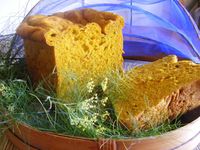
- 1 large peeled carrot - grated
- 20 g fennel seeds
- 15 g turmeric powder
- 40 g sugar - instead of the quantity in your bread recipe
Bear in mind that turmeric does stain so try not to spill any and,
if kneading by hand, it might be worth using some disposable gloves!
However the extra effort is really worthwhile.
This sounds a lot of fennel and turmeric and I was sceptical before I made the bread,
but the fennel and carrot make the bread sweet and aromatic and the turmeric,
as well as giving an amazing colour, gives a great depth of flavour to the loaf.
Cool and serve either just with butter or spread with soft cheese.
Rosemary and chocolate chip loaf cake

This serves at least 10 - 12 people and makes 2 cakes, one for tea and one to freeze, if you can get it in the freezer quick enough before it is eaten!
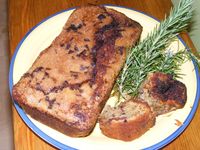
- 2½ tbs finely chopped rosemary leaves
- 120 g caster sugar
- 200 g plain flour
- 100 g ground almonds
- 2 tsp baking powder
- ½ tsp salt
- 240 ml olive oil
- 180 ml milk
- 3 medium eggs
- 1 tsp vanilla essence
- 150 g good dark chocolate - roughly grated
- 2 tbs demerara sugar
The oven should be preheated to 175ºC (160ºC fan) / 350ºF / Gas Mark 4.
Meanwhile line 2 loaf tins - each approx. 20 x 12cm with baking paper
and grease the inside of the paper with a little olive oil.
In a large mixing bowl, grind the rosemary and sugar together with the back of a wooden spoon
to bruise the rosemary and release its flavours.
Add the rest of the dry ingredients and mix well.
Measure the olive oil and milk into a 1L graduated jug, add the vanilla and eggs and whisk thoroughly.
Mix the liquid into the dry ingredients until well combined, then stir in most of the grated chocolate, reserving about 2 tbs.
Pour the cake batter equally into the 2 tins and sprinkle over the remaining chocolate along with the demerara sugar.
Bake for 45 – 50 minutes, and then allow to cool in the tins for 20 minutes before transferring to a cake rack.